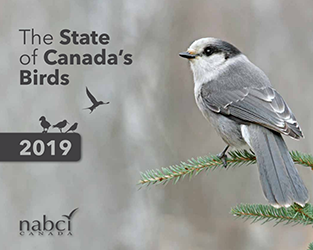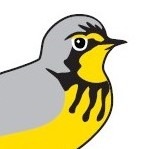
June 20, 2019, (Ottawa, ON) – Human activities have resulted in dramatic changes to Canada’s bird populations over the last 50 years. This is the conclusion of the second State of Canada’s Birds report, published today by the North American Bird Conservation Initiative in Canada (NABCI-Canada), under the leadership of Environment and Climate Change Canada, Bird Studies Canada, Nature Canada and Ducks Unlimited Canada.
The report looks at how populations have changed since 1970 for waterfowl, birds of prey, wetland birds, seabirds, forest birds, shorebirds, grassland birds, aerial insectivores and other birds. These groups include 449 Canadian bird species.
Several bird groups have experienced significant declines. Canada has lost 40% to 60% of shorebird, grassland bird and aerial insectivore populations. These groups make up 80% of all bird species that were newly assessed as threatened or endangered in Canada over the last decade. The loss of important lands and waters, unsustainable agricultural practices, climate change and pollution are the most important causes of these declines. These threats affect birds on their Canadian breeding grounds, during their migration and on their wintering grounds, highlighting the need for strong international conservation action.
Over the same period, other species have benefited from investments in conservation by government, non-government and industry organizations. Geese and duck populations have increased by 360% and 150%, respectively, since 1970. Some goose species have also taken advantage of increased waste grain in agricultural areas and are now so abundant that there is concern about the potential impacts of these birds on other species. Populations of birds of prey have increased by 110% thanks to the ban on the indiscriminate use of DDT. When we understand the problem and take action together, conservation works.
This collaborative report is both a call for action for bird conservation and a testament to what we can achieve when we work together. The report describes the transformative changes that we can each make to ensure a healthier Canada for both birds and people. The report also underscores the urgency of making those changes before species disappear from the Canadian landscape.
The report is available here: www.stateofcanadasbirds.org
Quotes
“From the Common Loon to the Canada goose, birds across our country symbolize the nature we love. Canada is doubling the amount of nature protected in our lands and oceans, which will help save the animals that depend on them. We will continue to conserve, protect, and recover Canada’s migratory birds, using science, Indigenous knowledge, and cooperation.”
– Catherine McKenna, Minister of Environment and Climate Change
“The State of Canada’s Birds is a timely and useful report that serves as a call to action to address the extinction crisis that our bird populations are confirming. Grassland birds, aerial insectivores and shorebirds continue to decline the fastest. Fortunately, the report also contains many steps we can take to improve the chances for these bird populations. Nature Canada’s work focuses on doubling protected areas, supporting Indigenous-led conservation of shorebirds and working with farmers to save declining swallow populations, in order to help the species in most need.”
– Ted Cheskey, Naturalist Director, Nature Canada
“The data provided by thousands of citizen science volunteers and professional biologists in this report have helped reveal dramatic declines in many birds once common in Canada. Taking action now, particularly for aerial insectivores, shorebirds and grassland birds, is essential so that future data will tell a more positive story for birds as well as for the ecosystems on which all life depends.”
– Steven Price, President, Bird Studies Canada
“The second State of the Birds report published today is a testament that partnership-based, science-driven conservation can make a difference. Conservation approaches have benefitted waterfowl, but we must remain vigilant in face of habitat loss and climate instability. We need a continued commitment by Canadians to protect our natural spaces.”
– Karla Guyn, CEO, Ducks Unlimited Canada
Quick Facts
• This report is the second comprehensive assessment of the population status of all bird species that occur in Canada.
• The report reveals major declines in shorebirds, grassland birds and aerial insectivores.
• Canada seasonally hosts approximately 450 species of birds, the majority of which are protected under the Migratory Birds Convention Act, 1994.
• Loss of habitat due to urban and coastal development, agriculture and other changes in land use is among the main threats to migratory birds.
• Birds contribute to our economy through birdwatching and hunting. In addition, birds help keep our forests and farms healthy by eating pests.
• Conservation works. Where actions have been taken, birds have recovered.
• Skilled volunteer citizen scientists are vital to the monitoring programs that provided the data for 66% of the species trends included in this scientific analysis. Professional biologists coordinate the large-scale volunteer programs and analyze the data. They also monitor challenging species, such as seabirds and waterfowl.
• The North American Bird Conservation Initiative in Canada (NABCI-Canada) is a coalition of federal, territorial and provincial governments, conservation organizations, and industry groups.
-30-
Contacts:
Environment and Climate Change Canada
Media Relations
819-938-3338 or 1-844-836-7799 (toll-free)
ec.media.ec@canada.ca
Bird Studies Canada
Ruth Friendship-Keller
Director of Communications
rfriendshipkeller@birdscanada.org
519-586-3531, ext. 111, or 1-888-448-2473 (toll-free)
Nature Canada
Haley Ritchie
Digital Communications
hritchie@naturecanada.ca
613-562-3447, ext. 252
Ducks Unlimited Canada
Jennifer Sanford
National Communications and Marketing
j_sanford@ducks.ca
236-990-4996

